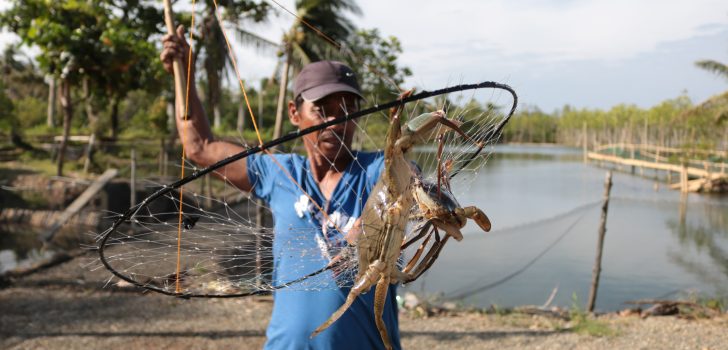 A sta at the Catanduanes Marine Multi-species Fish Hatchery in Virac shows a marketable mangrove crab from the facility. (Photo by Ana Francesca Chavez)
A sta at the Catanduanes Marine Multi-species Fish Hatchery in Virac shows a marketable mangrove crab from the facility. (Photo by Ana Francesca Chavez) Catanduanes crablet industry to grow bigger and better with PRDP
The Province of Catanduanes is widely known as the top producer of abaca fiber in the Philippines. Soon, it will also be famous as the country’s “crab capital.”
Based on the Mangrove Crab Value Chain Analysis (VCA), the province is not listed among the leading crab-producing provinces in the country. However, the report states that Catanduanes is the primary source of crablets of fishpond operators in Sorsogon, Masbate, Camarines Sur, Camarines Norte, Roxas City, Pangasinan, Pampanga, Bulacan, and Mindanao.
The province’s 1,595 hectares of potential crab production area and wild seedstocks are also identified as positive variables to the provincial policy to “Make Catanduanes the Crab Capital of the Philippines.”
This is in line with Republic Act No. 10857 or the Act Establishing Mangrove Crab Seed Banks, Nurseries and Grow-Out Production Farms in the Municipalities of Virac, Bato, Baras, Gigmoto, Viga, Panganiban, Bagamanoc, San Andres, Caramoran, and Pandan.
PRDP research project
In March 2017, the World Bank approved the first subproject under the subcomponent 1.2 or the support to Agriculture and Fisheries Modernization Plan (AFMP) implementation of the PRDP’s local and national level planning (I-PLAN) component.
Entitled “Mangrove Resource Mapping and Stakeholders’ Engagement for Sustainable Crab Industry Development in Catanduanes,” the P1.25 million-worth subproject will be led by the research team of the Catanduanes State University (CSU).
The research project aims to assess the population dynamics of mangrove crablets, the physico-chemical and biological characteristics of their habitat, and the carrying capacity of mangrove and fishpond areas in Catanduanes to increase the production of crablets. It also aims to develop a roadmap, which will contain action plans and strategies to establish mangrove crabs as the priority commodity of Catanduanes.
After the research completion, the Provincial Local Government Unit (LGU) of Catanduanes in partnership with the Bureau of Fisheries and Aquatic Resources (BFAR) and the Department of Environment and Natural Resources (DENR) will take full responsibility and implement the recommended actions.
Environment protection
Based on the VCA, many mangrove crab areas in Catanduanes are unprotected and relatively disturbed. They have also become less productive because of illegal and destructive fishing activities.
Threats to mangrove crabs, which are recognized as environmentally significant species, also pose risks to the ecosystem which includes the plants and animals in the mangrove areas.
Through the subproject, the CSU will identify key stakeholders and the needed improvement for the policy directions that will have significant impact on the development of the mangrove crab industry. This will be included in the province’s mangrove crab roadmap together with the identified roles of partner agencies in the Mangrove Crab Industry Governance Network.
Mangrove crab enterprise
The Catanduanes PLGU in partnership with the Panganiban Fisherfolks Association, Inc. (PFA) also proposed an enterprise development (I-REAP) subproject for the development of the mangrove crab industry.
Entitled “Mangrove Crab Production and Marketing Enterprise,” the approved I-REAP subproject worth P9.46 million will involve the buying of crablets and selling of marketable-size crabs. It will add value to the commodity by growing and fattening the crabs through different farming methods such as aquasilviculture, pond culture, and crab cages in identified mangrove areas.
The PFA, which is composed of 132 members, also aims to protect and conserve the fisheries and aquatic resources in the municipal water of Panganiban with the help of their enterprise.
Investments from partner agencies
Other investments in the development of the Catanduanes mangrove crab industry have been identified during the first PRDP-led interagency convergence initiative in the Bicol Region, which was held in Virac in May 2017.
During the signing of the Memorandum of Understanding (MOU) for the interagency convergence, the provincial LGU gathered the representatives of key national and regional government and nongovernment agencies, funding institutions, and the CSU.
By signing the MOU, the partner agencies expressed their commitment towards the implementation of the Provincial Commodity Investment Plan (PCIP) on abaca and mangrove crab.
As a result of the convergence, more projects are expected for the development of the abaca and mangrove crab industries of Catanduanes. ### (Gumamela Celes Bejarin, DA-PRDP South Luzon PSO InfoACE Unit)
